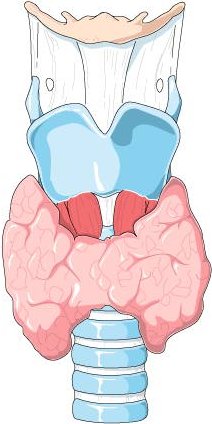


Hypothyroidism is an endocrine disorder resulting from a deficiency of thyroid hormones in the blood. This is usually due to an underactive thyroid gland that does not release enough thyroid hormone.
Thyroid hormones are produced in the thyroid gland. The thyroid gland is located in the front part of the neck, under the Adam's apple. It has a butterfly shape and wrapped around the windpipe (trachea). The thyroid gland has two similar-sized lobes joined by an isthmus across the front of the trachea.

Figure 1. Thyroid
Thyroid hormones are essential for the cells. They play an important role in growth and development, heart rate, blood pressure, body temperature, and metabolic rate (the rate at which food is converted into energy in the body cells).
The thyroid gland uses iodine to produce thyroid hormones.
The 2 most important thyroid hormones are:
The T4 hormone contains 4 iodine molecules, while the T3 hormone only contains 3 iodine molecules.
The iodine needed to produce thyroid hormones is found in fish and mollusks, bread, and iodized salt.
More than 99% of all thyroid hormones are bound to proteins in the blood and are inactive, meaning they cannot interact with the body's cells. Only a small fraction of circulating thyroid hormones are free, unbound to proteins. This small fraction of thyroid hormones is essential for the regulation of cellular metabolism.
The production of thyroid hormones is controlled by the release of a hormone called TSH (Thyroid Stimulating Hormone) produced by the pituitary gland or hypophysis. This gland is located at the base of the brain.
When there is an excess of thyroid hormones in the blood, the pituitary gland stops the secretion of TSH, and vice versa. This helps maintain a relatively constant level of circulating thyroid hormones in the blood.
When a person suffers from hypothyroidism, the concentration of thyroid hormones T3 and T4 in the body decreases.
However, depending on the reason of the decreased production of thyroid hormones, hypothyroidism can be classified into:
Secondary and tertiary hypothyroidism is usually group together and called central hypothyroidism.
The main underlying causes that causes hypothyroidism are:
Hypothyroidism is the most common thyroid disease. It affects 3-5% of the general population.
Women are more likely to suffer hypothyroidism than men with a female-to-male ratio of 6 to 1.
Patients with mild hypothyroidism may be asymptomatic. Symptoms become more evident as the disease develops. They usually produce a metabolism slowdown.
The most common symptoms are:
Other symptoms relate to hypothyroidism may include:
Hypothyroidism can be successfully treated. However, if left untreated, it can lead to serious heart disease (cardiomyopathy, heart failure), as well as a very serious situation called myxedema coma. Stress, concomitant diseases, or surgery in a previous severe hypothyroid state usually triggers myxedema coma. It must be treated in a hospital with intravenous thyroid hormone therapy.
Furthermore, the treatment of hypothyroidism is based on the replacement of thyroid hormones with the T4 (thyroxine) synthetic hormone called levothyroxine. The daily dose is usually 100-150 micrograms (0.100 to 0.150 milligrams). After six weeks of treatment, thyroid hormones (T3 and T4) and TSH hormone levels should be measured.
The ultimate goal of the treatment is to maintain a normal level of TSH, which is the main priority (a normal level of thyroid hormones will be the other objective). Overtreatment of hypothyroidism is as dangerous as not treating it.
Show more